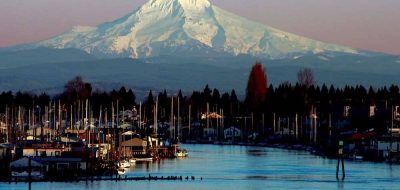 The End of the Road – From Alabama to Tybee Island
The End of the Road – From Alabama to Tybee Island
By Pam Selbert
As we begin the fourth–and final–stretch of our cross-country trek following U.S. Highway 80 from San Diego, California to Tybee Island, Georgia, we drive into the “Heart of Dixie”–Alabama–near tiny Cuba.
From here to Phenix City, the last stop before Georgia, U.S. 80 plows a near-straight furrow across the state, bisecting the “river heritage” region, where some of the most dramatic chapters in American history were written from the War of 1812 and Civil War days through the Civil Rights era.
The Dixie Overland Highway
RVers might be surprised to see road signs identifying the route not only as Highway 80 (and Alabama Highway 8), but also as the “Dixie Overland Highway.” Of the eight states the old road crossed, before it was decommissioned west of Dallas, only Alabama retains the original name, given when this “shortest and straightest road across the country: was posted in 1914.
Continue east to Demopolis, Greek for “city of the people,” on the Tombigbee River. The first white settlers here were a small group of French expatriates who had come to the United States after fleeing a slave rebellion on the sugar plantations of Haiti. They petitioned Congress, which allowed them to buy land at $2 an acre, provided they would grow grape vines and olive trees, and in 1817 they established the Vine and Olive Colony. However, the next year they learned the land was not within Congress-approved territory and they were forced to leave. But after nearly two centuries, remnants of the olive trees they planted remain.
Attractions at the town, which inspired Lillian Hellman’s ”The Little Foxes,” are Greek-Revival Gaineswood, built 1843-61 and listed on the National Register of Historic Places; Federal-style Bluff Hall, new in 1832 and also on the National Register; and Laird Cottage/Geneva Mercer Museum, a restored 1870 Greek Revival-ltalianate home, now headquarters of the Marengo County Historical Society. The museum features history exhibits and works of local sculptor Geneva Mercer.
Selma: From Civil War to Civil Rights
The next major stop is Selma, population 20,500, on the Alabama
River. The town is best known today for the 1965 Selma Voting Rights Movement and the three Selma-to Montgomery Civil Rights marches. But a century earlier, during the Civil War, Selma was important as one of the South’s main military manufacturing centers, prompting frequent Union raids into the state.
In more recent history, although more than half the town’s residents were African-American, only one percent was registered to vote. On March 7,1965, “Bloody Sunday,” 600 Civil Rights marchers, in a non-violent protest, left Selma headed east on Highway 80. They made it six blocks to the Edmund Pettus Bridge, where state troopers and local sheriff’s deputies met them with clubs and tear gas, forcing them back to town.
Two days later, Dr. Martin Luther King, Jr. led a symbolic march to the bridge. Then, with other Civil Rights leaders, he got court protection for a larger march to the state capital, 50 miles east. This time, March 21, 1965, 3200 marchers set out, walking a dozen miles a day, sleeping in fields, and by the time they reached Montgomery four days later their numbers had grown to 25,000. Less than five months later President Lyndon Johnson signed the Voting Rights Act of 1965. In 1996 Congress designated the Selma to Montgomery stretch of Highway 80 a “National Historic Trail,” the highest tribute a road can receive under the National Scenic Byway Program.
Selma’s attractions include the 1866 Brown Chapel AME Church, headquarters for the Voting Rights Movement; Edmund Winston Pettus Bridge, on the National Register of Historic Sites; National Voting Rights Museum; Old Depot Museum, with historical displays, early Native Americans through the Civil Rights Movement; and the Slavery and Civil War Museum. Also of interest are Sturdivant Hall Museum, and Old Town Historic District, Alabama’s largest contiguous Historic District with more than 1250 structures.
Montgomery Confederate Capital
Continue east to Montgomery, incorporated in 1819. Also on the Alabama River, it became the state capital in 1846, and in 1861, the first capital of the Confederacy (moved later that year to Richmond). This part of the state was first settled by whites after the Battle of Horseshoe Bend, (near today’s Alexander City) ended the Creek War of 1814, part of the War of 1812, and the Native Americans-the Albaamaha-were forced to give up much of their land.
Montgomery, scene of the 1955-56 Bus Boycott, and mob violence at the Greyhound Bus Station when Freedom Riders arrived in 1961, among other incidents, also played an important role during the Civil Rights era. In addition to the expected Civil Rights sites-Dexter Parsonage Museum (Dr. Martin Luther King, Jr.’s home from 1954 to 1960), Rosa Parks Museum, and Civil Rights Memorial-Montgomery’s offerings include the magnificent Alabama State Capitol First White House of the Confederacy, a Museum of Fine Arts, first-rate Zoo, Hank Williams Museum and more.
The drive continues through piney woods to Tuskegee, where a Black History Trail has been developed. Among the stops are Tuskegee Institute National Historic Site and Tuskegee Airmen National Historic Site. Under Booker T. Washington’s determined leadership, Tuskegee offered an education that included learning a trade to the children of former slaves. George Washington Carver came here to teach at Washington’s invitation, and through his research changed the lives of poor area farmers. Exhibits at the excellent Carver Museum depict the lives of the two men.
East of town is the Tuskegee Airmen National Historic Site, where the first African-American aviators to serve in the U.S. military trained to become, among others, the famed 332nd Fighter Group. They flew successful missions over Sicily, the Mediterranean 1 and North Africa, were awarded numerous honors, and helped clear the way for integration in the U.S. military. Photos and artifacts tell the story.
Ahead on the Chattahoochee River is Phenix City, a suburb of Columbus, Georgia to the east. Phenix City attractions include the East Alabama Motor Speedway, Idle Hour Park, and Fort Mitchell National Landmark Site. For more information about Alabama attractions, visit alabama.travel.
Columbus & Side Trips
Columbus, fourth largest metro area in the state, offers numerous reasons to visit. They include the Coca-Cola Space Science Center; Black History Museum; 15-mile Riverwalk, a “linear park” for walking, biking and fishing along the Chattahoochee; Ma Rainey “Mother of the Blues” House Museum; Port Columbus National Civil War Naval Museum; Springer Opera House and others. But Columbus also serves as a fine base for short side-trips, of which three in particular should not be missed: the Jimmy Carter National Historic Site in Plains; Andersonville National Historic Site (45,000 Union prisoners of war were detained at the infamous Civil War facility), and Roosevelt’s Little White House Historic Site in Warm Springs.
Musical Macon
East of Columbus Highway 80 meanders 50 miles through pastoral landscape to Macon, a town of 95,000, and birthplace of performers Little Richard, Otis Redding and the Allman Brothers. Attractions include Ocmulgee National Monument (to Georgia’s prehistoric mound builders, believed to be ancestors of the Creek Indians); Cannonball House and Civil War Museum in a restored 1853 Greek Revival manse; Georgia Music Hall of Fame; Georgia Sports Hall of Fame, the largest state sports hall of fame in the U.S.; the 1840 Sidney Lanier Cottage, birthplace of the famous poet; Tubman African-American Museum (named for Harriet Tubman who led hundreds of slaves to freedom on the Underground Railroad); and Muddy Water Tours on the Ocmulgee River.
Sunny Savannah
The drive continues east through Jeffersonville, Dublin, Swainsboro and Statesboro, then southeast into lovely Savannah where, nearly a century ago the historic road we’ve been traveling was conceived and plotted, and originally began. In 1929 the final stretch to Tybee Island was added, crossing islands and marshes along the Atlantic to the island’s tip. RVers can take a short side trip from Tybee across the Savannah River to Fort Pulaski National Monument on nearby Cockspur Island. The Confederate fort was taken in 1862 by Union forces on Tybee Island, two and a half miles away, in the first successful use of rifled cannon. With the victory, brick fortifications became obsolete, and Savannah was lost to the South as a viable port.
Tybee Island Light Station, the third lighthouse to stand on the site and the oldest operational lighthouse in Georgia, is another short side-trip of interest. The lower 60 feet of the black and white structure, a popular tourist attraction that includes a museum, date from 1773; the top 94 feet were added in 1867, the year steamships began bringing tourists to the island. A nature lover’s paradise, Tybee claims five miles of elegant, uninterrupted public beach, Georgia’s widest and longest. For more information about Georgia attractions, visit exploregeorgia.org.
Trail’s End
Highway 80 continues along Butler Avenue to Tybrisa Street, where a monument reads: Ahead at 19th Street the historic road, the one-time Boulevard of America that we set out on more than 2700 miles ago at the Pacific Ocean, comes to an end just a few hundred feet short of the Atlantic Ocean. Though no longer a major east-west transcontinental thoroughfare, U.S. 80 still offers a unique look at America that interstate highways can’t rival. And it’s waiting for you to explore at your leisure. Pull out of the fast lane, pull out your road atlas and plan your trip today!




